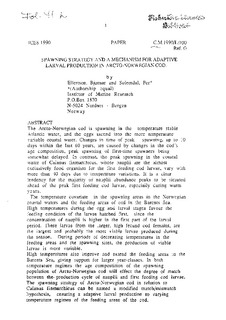| dc.contributor.author | Solemdal, Per | |
| dc.contributor.author | Ellertsen, Bjørnar | |
| dc.date.accessioned | 2012-08-23T10:56:41Z | |
| dc.date.available | 2012-08-23T10:56:41Z | |
| dc.date.issued | 1990 | |
| dc.identifier.citation | This report is not to be cited without prior reference to the authors | no_NO |
| dc.identifier.uri | http://hdl.handle.net/11250/104805 | |
| dc.description.abstract | The Arcto-Norwegian cod is spawning in the temperature stable
Atlantic water, and the eggs ascend into the more temperature
variable coastal water. Changes in time of peak spawning, up to 10
days within the last 60 years, are caused by changes in the cod´s
age composition, peak spawning of first-time spawners being
somewhat delayed. In contrast, the peak spawning in the coastal
water of Calanus finmarchicus, whose nauplii are the almost
exclusively food organism for the first feeding cod larvae, vary with
more than 40 days due to temperature variations. It is a clear
tendency for the majority of nauplii abundance peaks to be situated
ahead of the peak first feeding cod larvae, especially during warm
years.
The temperature covariate in the spawning areas in the Norwegian
coastal waters and the feeding areas of cod in the Barents Sea.
High temperatures during the egg and larval stages favour the
feeding condition of the larvae hatched first, since the
concentration of nauplii is higher in the first part of the larval
period. These larvae from the larger, high fecund cod females, are
the largest and probably the most viable larvae produced during
the season. During periods of decreasing temperatures in the
feeding areas and the spawning sites, the production of viable
larvae is more variable.
High temperatures also improve and extend the feeding areas tn the
Barents Sea, giving support for larger year-classes. In both
temperature regimes the age compostition of the spawning
population of Arcto-Norwegian cod will effect the degree of match
between the production cycle of nauplii and first feeding cod larvae.
The spawning strategy of Arcto-Norwegian cod in relation to
Calanus finmarchicus can be named a modified match/mismatch
hypothesis, ensuring a adaptive larval production to varying
temperature regimes of the feeding areas of the cod. | no_NO |
| dc.language.iso | eng | no_NO |
| dc.publisher | ICES | no_NO |
| dc.relation.ispartofseries | ICES CM Documents;1990/L:100 | |
| dc.subject | spawning areas | no_NO |
| dc.subject | gyteplasser | no_NO |
| dc.subject | cod | no_NO |
| dc.subject | torsk | no_NO |
| dc.subject | food supply | no_NO |
| dc.subject | mattilgang | no_NO |
| dc.title | Spawning strategy and a mechanism for adaptive larval production in Arcto-Norwegian cod | no_NO |
| dc.type | Working paper | no_NO |
| dc.subject.nsi | VDP::Agriculture and fishery disciplines: 900::Fisheries science: 920::Resource biology: 921 | no_NO |
| dc.subject.nsi | VDP::Mathematics and natural science: 400::Geosciences: 450::Oceanography: 452 | no_NO |
| dc.subject.nsi | VDP::Mathematics and natural science: 400::Zoology and botany: 480::Marine biology: 497 | no_NO |
| dc.source.pagenumber | 19 s. | no_NO |
